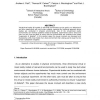Free Online Productivity Tools
i2Speak
i2Symbol
i2OCR
iTex2Img
iWeb2Print
iWeb2Shot
i2Type
iPdf2Split
iPdf2Merge
i2Bopomofo
i2Arabic
i2Style
i2Image
i2PDF
iLatex2Rtf
Sci2ools
PSYCHNOLOGY
2008
2008
The Use of Virtual and Mixed Reality Environments for Urban Behavioural Studies
Virtual/mixed reality 3D models of real-world environments can be used to run behavioural and other experiments with real human subjects, replacing the traditional approach where studies are conducted in physical environments. Use of the virtual/mixed reality environments can minimize problems related to feasibility, experimental control, ethics and cost, but care must be taken to ensure that the environments are immersive and create "suspension of disbelief". In this position paper the issues involved are discussed and illustrated by a 3D virtual model of an urban environment that is being used to study the role of fear in pedestrian navigation.
| Added | 28 Dec 2010 |
| Updated | 28 Dec 2010 |
| Type | Journal |
| Year | 2008 |
| Where | PSYCHNOLOGY |
| Authors | Andrew J. Park, Thomas W. Calvert, Patricia L. Brantingham, Paul J. Brantingham |
Comments (0)

